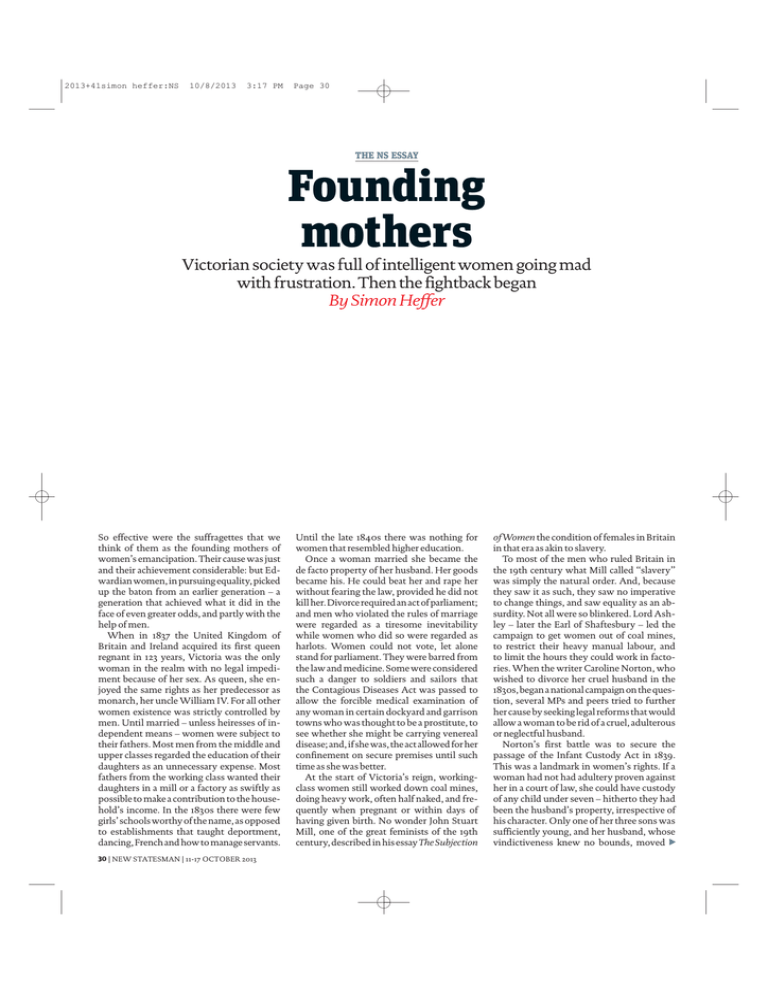Founding mothers Victorian society was full of intelligent women going mad
advertisement

2013+41simon heffer:NS 10/8/2013 3:17 PM Page 30 THE NS ESSAY Founding mothers Victorian society was full of intelligent women going mad with frustration. Then the fightback began By Simon Heffer 30 | NEW STATESMAN | 11-17 OCTOBER 2013 Until the late 1840s there was nothing for women that resembled higher education. Once a woman married she became the de facto property of her husband. Her goods became his. He could beat her and rape her without fearing the law, provided he did not kill her. Divorce required an act of parliament; and men who violated the rules of marriage were regarded as a tiresome inevitability while women who did so were regarded as harlots. Women could not vote, let alone stand for parliament. They were barred from the law and medicine. Some were considered such a danger to soldiers and sailors that the Contagious Diseases Act was passed to allow the forcible medical examination of any woman in certain dockyard and garrison towns who was thought to be a prostitute, to see whether she might be carrying venereal disease; and, if she was, the act allowed for her confinement on secure premises until such time as she was better. At the start of Victoria’s reign, workingclass women still worked down coal mines, doing heavy work, often half naked, and frequently when pregnant or within days of having given birth. No wonder John Stuart Mill, one of the great feminists of the 19th century, described in his essay The Subjection of Women the condition of females in Britain in that era as akin to slavery. To most of the men who ruled Britain in the 19th century what Mill called “slavery” was simply the natural order. And, because they saw it as such, they saw no imperative to change things, and saw equality as an absurdity. Not all were so blinkered. Lord Ashley – later the Earl of Shaftesbury – led the campaign to get women out of coal mines, to restrict their heavy manual labour, and to limit the hours they could work in factories. When the writer Caroline Norton, who wished to divorce her cruel husband in the 1830s, began a national campaign on the question, several MPs and peers tried to further her cause by seeking legal reforms that would allow a woman to be rid of a cruel, adulterous or neglectful husband. Norton’s first battle was to secure the passage of the Infant Custody Act in 1839. This was a landmark in women’s rights. If a woman had not had adultery proven against her in a court of law, she could have custody of any child under seven – hitherto they had been the husband’s property, irrespective of his character. Only one of her three sons was sufficiently young, and her husband, whose vindictiveness knew no bounds, moved t So effective were the suffragettes that we think of them as the founding mothers of women’s emancipation. Their cause was just and their achievement considerable: but Edwardian women, in pursuing equality, picked up the baton from an earlier generation – a generation that achieved what it did in the face of even greater odds, and partly with the help of men. When in 1837 the United Kingdom of Britain and Ireland acquired its first queen regnant in 123 years, Victoria was the only woman in the realm with no legal impediment because of her sex. As queen, she enjoyed the same rights as her predecessor as monarch, her uncle William IV. For all other women existence was strictly controlled by men. Until married – unless heiresses of independent means – women were subject to their fathers. Most men from the middle and upper classes regarded the education of their daughters as an unnecessary expense. Most fathers from the working class wanted their daughters in a mill or a factory as swiftly as possible to make a contribution to the household’s income. In the 1830s there were few girls’ schools worthy of the name, as opposed to establishments that taught deportment, dancing, French and how to manage servants. 10/8/2013 3:17 PM Page 31 UNDERWOOD & UNDERWOOD/CORBIS/COLOUR MANIPULATED IMAGE 2013+41simon heffer:NS Daughters of the revolution: early feminists struck a blow for freedom by taking to their bicycles. Their motor-riding successors won women the vote 11-17 OCTOBER 2013 | NEW STATESMAN | 31 3:17 PM them to Scotland, where the act did not apply. It was not until her youngest son died of lockjaw in 1842 that she was allowed custody of the other two boys – then aged 13 and 11 – for half the year. There were several attempts in the 1840s and early 1850s to bring in a divorce law that would treat women compassionately. A wider campaign was already under way for property rights for women, led by Barbara Bodichon, the leading feminist of the 1850s. Lord Cranworth, the lord chancellor, laid a bill in the House of Lords in 1854 to make divorce more widely available. It was sidelined over the next year. Only when Palmerston, the prime minister and a legendary womaniser, adopted the idea – in the teeth of attritional opposition from Gladstone, citing religious objections – that the measure finally passed into law in the summer of 1857. By then, however, 10,000 clergy had signed a petition against divorce. It demanded: “Remembering also, that it is declared in the Word of God, that marriage with a divorced woman is adulterous, we fervently pray that the Clergy of this realm may never be reduced to the painful necessity of either withholding the obedience which they must always desire to pay to the law of the land, or else of sinning against their own consciences, and violating the law of God by solemnising such marriages as are condemned as adulterous in His Holy Word.” Such objections were to no avail. There were three divorce cases in 1857, but 300 in 1858, the act coming into force on 1 January that year. T he first stirrings of the feminist movement came in the field of education. Some radical families allowed their daughters to cultivate minds of their own and it was the products of such families who sought, in the 1840s, to found a college for women to provide a higher education such as men of the upper classes could take for granted. Victorian literature – as with Victorian reality – abounds with intelligent women going mad with frustration, denied the means to sate their intellectual curiosity and the opportunity to pursue a career. The embittered Mrs Transome, in George Eliot’s Felix Holt, the Radical, is virtually imprisoned in her gloomy Midlands mansion. Florence Nightingale, by force of character, ensured her parents could not stop her training as a nurse; her elder sister Parthenope was so frustrated by her own lack of opportunity, and so envious of Florence’s success, that she became, for a time, a chronic hysteric. Ladies’ colleges began in London with support from the Christian Socialist Frederick Denison Maurice and his disciple Charles Kingsley, the author of The Water Babies. In 32 | NEW STATESMAN | 11-17 OCTOBER 2013 Page 32 1849 Elizabeth Jesser Reid, a Unitarian philanthropist, founded what came to be known as Bedford College, the first institution for the higher education of women in Great Britain. By the 1870s, colleges offering something like a university education were at last available to women at the ancient universities, even if Cambridge – the first of the old institutions to agree to allow women to attend lectures – still refused to award them degrees (and, to its shame, continued to refuse until 1948). Emily Davies was a pioneer of the movement that stormed Oxbridge and she brought with her feminist views that followed the idea of education of women to a logical conclusion: women should also have the vote, There were three divorce cases in 1857 but 300 in 1858, after the act came in and should find none of the professions barred to them. Davies was born in 1830, the daughter of a clergyman, John Davies, who consigned her to a life of assisting with the family needlework and, when old enough, doing good works in Gateshead, his parish. Davies resented this; in her twenties, she met two women who inspired her to campaign for women’s education and suffrage. One was Elizabeth Garrett, six years her junior, who would become the first female doctor in Britain; the other Barbara Bodichon, three years her senior. Bodichon was known for her campaign to reform women’s property rights, which succeeded in the early 1870s. She was also one of the most prominent members of the Langham Place circle of feminists and a first cousin of Florence Nightingale: but Barbara was illegitimate and much of the family refused to know her. She was educated by private tutors and at various schools; and when “It’s an idea, Ted, but I don’t think we should offer loyalty points at a funeral director’s” she came of age in 1848 her father gave her shares and property to provide a private income, allowing her the independence to pursue her main career interest (which was to become an artist) and to engage in political campaigning. That led her into close associations with Mill, through his stepdaughter Helen Taylor, and George Eliot. She regarded her money as “a power to do good . . . a responsibility we must accept”. Visiting London in 1859, Davies and Garrett attended lectures given by Elizabeth Blackwell, an Englishwoman who had become the first female doctor in the United States, and who inspired Garrett’s campaign in Britain. Blackwell had been urged to come to Britain by Bodichon, to help Garrett’s campaign. Davies also joined the Society for Promoting the Employment of Women, and joined Garrett’s movement to persuade London University to award degrees to women. She edited the English Woman’s Journal, which Bodichon and others had founded in 1858 as an organ of feminism. One of her campaigns was to allow girls to take the Cambridge local examinations, in which she had the support of Matthew Arnold, who wanted female teachers to have a recognised qualification. When it succeeded, Davies found 83 girls in just six weeks to take the exams, 25 of them from Frances Buss’s North London Collegiate School. It was also thanks to one of Davies’s campaigns that the Taunton commission of inquiry into endowed schools considered the education of middle-class girls as well as that of middle-class boys. When she gave evidence to it in 1865 it was the first time a woman had ever appeared in person as an expert witness before a royal commission. D avies was determined to found a women’s college at Cambridge that would award degrees: Oxford was deemed too hostile. A committee including eminent dons met in December 1867, under Davies’s direction, to set about raising the £30,000 needed. Bodichon, who had financed a secular coeducational school in London from 1854 to 1863, gave much of her time, and some of her money. What Davies sought for her college was subtly, but radically, different from what another group with similar ambitions hoped to achieve at Cambridge. Henry Sidgwick and Anne Clough had obtained the university’s agreement to establish special examinations for female students: these would not lead to a Cambridge degree, not least because of Sidgwick and Clough’s belief that the inadequacies of girls’ education made such an aspiration unrealistic. Davies despaired of this outlook, describing the proposed diluted examination as “devised to suit struggling governesses”. She wanted her students to follow GEORGE LEIGH 10/8/2013 t 2013+41simon heffer:NS 2013+41simon heffer:NS 10/8/2013 3:17 PM the same courses, attend the same lectures, and take the same degrees as men. She took out newspaper advertisements to promote the scheme and ask for money. The shock to the unthinking man was profound. “Our age has been so prolific of absurdities, that we cannot well be expected to feel any very great surprise at the incubation of one foolish project more,” steamed the Imperial Review. It went on to condemn “this preposterous proposal of a University career for the potential wives of Englishmen”, which was “calculated to unfit women for the performance of the very duties to which . . . women only are intended and adapted”. Davies and her supporters were, inevitably, hardened to their task by such bigotry. Girton was founded in 1869; Newnham soon followed, under Clough. With the extension of the franchise to working men in 1867, it was natural that the more reform-minded should turn their attention to the franchise for women. John Stuart Mill had tried unsuccessfully to push the point by organising petitions to be presented to parliament in 1866, 1867 and 1868. A bill to effect this was introduced in May 1870 by Jacob Bright, younger brother of John and of Priscilla Bright McLaren, an early campaigner for women’s suffrage. Bright argued “on the grounds of public justice and of practical necessity”. The householder franchise had led to men in an astonishing degree of ignorance being allowed to vote. Yet women who paid taxes, and who rendered valuable service to the nation – he invoked the name of Florence Nightingale – were not. The men who had demanded the vote before 1867 had argued that to be denied it was “tantamount to a declaration of our moral and intellectual inferiority”. He emphasised what he felt should be the link between taxation and representation and, even more boldly than demanding votes for women, highlighted the unfairness of their pay: “There is not a male and female rate of taxation, but there is a male and female rate of wages and earnings. Women everywhere, with a few remarkable exceptions, are getting far less money than men; they have to work much longer for the same money; and they are even paid much less when they are doing precisely the same work. Taxation must, therefore, fall somewhat more heavily upon women than on men.” There were, he protested, “inferior men in every rank of life” who “have no objection to degrade women and keep them in degradation”. The opposition to Bright was led by John Scourfield, the Tory MP for Pembrokeshire. He quoted Dr Johnson’s insulting line about a woman preaching being like a dog on its hind legs. He was clear about their purpose: “Their vocation is to make life endurable,” he said, and he simply wished them to continue Page 33 being “admirable, amiable, and delightful”. William Fowler, the MP for Cambridge, said that if women were given the vote there was no logical reason why they should not sit in the Commons, and therefore he was profoundly opposed to the bill. Women had duties – of educating their children, of having “to adorn the sphere in which they live” – that would be impeded by allowing them to become involved in politics. By the 1870s, having won rights to divorce and to own property, and having established places of education, women at last had the confidence to take on the men who would keep them down. None did it better than Elizabeth Garrett’s sister Millicent Fawcett, who shredded the arguments against femi- “There is not a male and a female rate of taxation . . . but one of wages” nism of one of the most reactionary political thinkers, James Fitzjames Stephen. She questioned his belief in the submission of women, as the weaker sex, to their husbands as a precept of the common law, asking: “Is the wife to obey the husband when, in obeying him, she does something she believes to be wrong? If the answer is ‘yes’, the possession of a husband may become the screen of all kinds of iniquity, from murder and robbery downwards. If the answer is ‘no’, everything is conceded that the advocates of equality in marriage demand, for many wives may and do think it wrong to encourage a spirit of despotism in their husbands by invariably allowing the husband’s authority to be supreme.” of indignation, at the leniency with which some of our judges treat offences of this kind.” The article had concluded, with deep disapproval, that an Englishman, “within certain limits, may beat his wife as much as he pleases”. Fawcett quoted the same newspaper, four months later, observing that “recent trials have revealed a prevalent indifference to the maltreatment of women, which is a heinous disgrace to English nature”. She noted that, among the better classes, women had small favours shown them – “being ‘seen home’ from evening parties, being helped first at dinner, having chairs offered, doors opened, umbrellas carried and the like” – but that they more than returned the compliment “by sewing on buttons, working slippers, and making puddings for the mankind of their domestic circles”. However, she said, “It is a small consolation for Nancy Jones, in Whitechapel, who is kicked and beaten at discretion by her husband, to know that Lady Jones, in Belgravia, is always assisted in and out of her carriage as if she were a cripple.” The tide of history was with Fawcett; the era of women as ornaments, appendages or full-time mothers was, thanks to her and others like her, nearing extinction. l Simon Heffer’s book “High Minds: the Victorians and the Birth of Modern Britain” is published by Random House (£30) F awcett ridiculed Stephen’s premise that, in return for submission, women received protection. “That is to say, in return for submission married women get the protection of losing all control over their own property; they also have the inestimable advantage of possessing no legal right to the guardianship of their own children even after the death of their husbands.” Twisting the knife, she pointed out that “in return for the submissiveness of women, little girls of twelve years old are, for the purposes of seduction, legally regarded as women – a most noteworthy instance, this, of the kind of protection the present state of the law affords”. She quoted an article in the Times from April 1872: “Every day the reports of our police courts and of our criminal tribunals still repeat the tale of savage and cowardly outrages upon women: and every day we have reason to marvel, not without a mixture 11-17 OCTOBER 2013 | NEW STATESMAN | 33 Copyright of New Statesman is the property of New Statesman Ltd. and its content may not be copied or emailed to multiple sites or posted to a listserv without the copyright holder's express written permission. However, users may print, download, or email articles for individual use.


